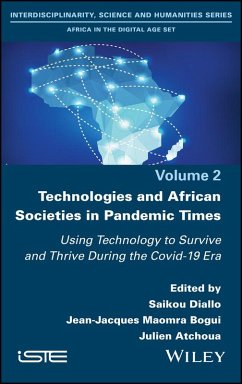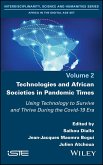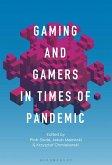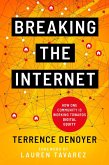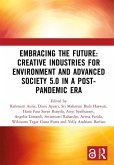Technologies and African Societies in Pandemic Times (eBook, ePUB)
Using Technology to Survive and Thrive During the Covid-19 Era
Redaktion: Diallo, Saikou Y.; Atchoua, Julien; Bogui, Jean-Jacques


Alle Infos zum eBook verschenken

Technologies and African Societies in Pandemic Times (eBook, ePUB)
Using Technology to Survive and Thrive During the Covid-19 Era
Redaktion: Diallo, Saikou Y.; Atchoua, Julien; Bogui, Jean-Jacques
- Format: ePub
- Merkliste
- Auf die Merkliste
- Bewerten Bewerten
- Teilen
- Produkt teilen
- Produkterinnerung
- Produkterinnerung

Hier können Sie sich einloggen

Bitte loggen Sie sich zunächst in Ihr Kundenkonto ein oder registrieren Sie sich bei bücher.de, um das eBook-Abo tolino select nutzen zu können.
In February 2020, the Coronavirus pandemic became a worldwide health emergency, and in April of that year, the ITU and the WHO created a joint declaration to show their commitment to using ICTs to overcome the pandemic. Technologies and African Societies in Pandemic Times explores the impact of Covid-19 on African societies in North and West Africa through the lens of technology and social media. The authors of this book highlight how everyday people dealt with the pandemic from its onset, through the process of the development of the vaccine and to its eventual dissemination. This book tells…mehr
- Geräte: eReader
- mit Kopierschutz
- eBook Hilfe
- Größe: 6.23MB
![Technologies and African Societies in Pandemic Times (eBook, PDF) Technologies and African Societies in Pandemic Times (eBook, PDF)]() Technologies and African Societies in Pandemic Times (eBook, PDF)142,99 €
Technologies and African Societies in Pandemic Times (eBook, PDF)142,99 €![Gaming and Gamers in Times of Pandemic (eBook, ePUB) Gaming and Gamers in Times of Pandemic (eBook, ePUB)]() Gaming and Gamers in Times of Pandemic (eBook, ePUB)91,95 €
Gaming and Gamers in Times of Pandemic (eBook, ePUB)91,95 €![The Other Pandemic (eBook, ePUB) The Other Pandemic (eBook, ePUB)]() James BallThe Other Pandemic (eBook, ePUB)12,95 €
James BallThe Other Pandemic (eBook, ePUB)12,95 €![Breaking the Internet (eBook, ePUB) Breaking the Internet (eBook, ePUB)]() Terrence DenoyerBreaking the Internet (eBook, ePUB)6,49 €
Terrence DenoyerBreaking the Internet (eBook, ePUB)6,49 €![Cybersecurity in the COVID-19 Pandemic (eBook, ePUB) Cybersecurity in the COVID-19 Pandemic (eBook, ePUB)]() Kenneth OkereaforCybersecurity in the COVID-19 Pandemic (eBook, ePUB)21,95 €
Kenneth OkereaforCybersecurity in the COVID-19 Pandemic (eBook, ePUB)21,95 €![Security and its Challenges in the 21st Century (eBook, ePUB) Security and its Challenges in the 21st Century (eBook, ePUB)]() Claudine GuerrierSecurity and its Challenges in the 21st Century (eBook, ePUB)139,99 €
Claudine GuerrierSecurity and its Challenges in the 21st Century (eBook, ePUB)139,99 €![Embracing the Future: Creative Industries for Environment and Advanced Society 5.0 in a Post-Pandemic Era (eBook, ePUB) Embracing the Future: Creative Industries for Environment and Advanced Society 5.0 in a Post-Pandemic Era (eBook, ePUB)]() Embracing the Future: Creative Industries for Environment and Advanced Society 5.0 in a Post-Pandemic Era (eBook, ePUB)0,00 €
Embracing the Future: Creative Industries for Environment and Advanced Society 5.0 in a Post-Pandemic Era (eBook, ePUB)0,00 €-
-
-
Dieser Download kann aus rechtlichen Gründen nur mit Rechnungsadresse in A, B, BG, CY, CZ, D, DK, EW, E, FIN, F, GR, HR, H, IRL, I, LT, L, LR, M, NL, PL, P, R, S, SLO, SK ausgeliefert werden.
- Produktdetails
- Verlag: John Wiley & Sons
- Seitenzahl: 208
- Erscheinungstermin: 12. Juli 2023
- Englisch
- ISBN-13: 9781394225897
- Artikelnr.: 68435566
- Verlag: John Wiley & Sons
- Seitenzahl: 208
- Erscheinungstermin: 12. Juli 2023
- Englisch
- ISBN-13: 9781394225897
- Artikelnr.: 68435566
- Herstellerkennzeichnung Die Herstellerinformationen sind derzeit nicht verfügbar.
Mohamed SALIOU CAMARA
Introduction xv
Jean-Jacques Maomra BOGUI and Nanga Désiré COULIBALY
Part 1 Covid-19, Information, and Communication 1
Chapter 1 Reinventing Everyday Life in the Covid-19 Era: The Uses of
Information and Communication Technologies as Tactics in an Abidjanese
"Ordinary Courtyard" 3
Youssouf SOUMAHORO
1.1 Introduction 3
1.1.1 Context and positioning of the research problem 3
1.1.2 Field and methods 5
1.2 Results 6
1.2.1 Social relational uses 6
1.2.2 Hedonic and playful uses 8
1.2.3 Emerging from the inactivity brought about by the pandemic 9
1.2.4 Uses for information retrieval and educational purposes 10
1.3 Conclusion 12
1.4 References 13
Chapter 2 Ambivalence of the Use of Digital Technologies in Public
Communication About the Pandemic in Côte d'Ivoire 15
Nanga Désiré COULIBALY
2.1 Introduction: Ivorian context of digital technology use in the Covid-19
period 15
2.1.1 Literature and defining the Covid-19 problem in the Ivorian context
17
2.1.2 Objectives and research questions 18
2.2 Conceptualization of the social uses of technology in public
communication 19
2.3 Collection and method for analyzing ambivalent uses of digital social
media in the face of Covid-19 in Côte d'Ivoire 21
2.4 Digital social media, a popular source of information about the
pandemic and a source of rumors and miscommunication 22
2.4.1 Digital social media, the preferred source of information 22
2.4.2 Rumors and fake news on digital social media, a remedy for
miscommunication 26
2.5 Conclusion: understanding the ambivalence of digital social media use
in times of Covid-19 27
2.6 References 30
Chapter 3 Fake News and Anti-Covid-19 Vaccines: Analysis of Facebook Users
in Burkina Faso 33
Marcel BAGARE
3.1 Introduction 33
3.2 Methodology 36
3.3 The profiles of Facebook users and their content 37
3.4 Fake news in the representation of vaccine risks 43
3.4.1 The Covid-19 vaccine makes women infertile 44
3.4.2 Covid vaccines cause neurodegenerative diseases 46
3.4.3 Bill Gates and his geo-tagged vaccine against Covid 47
3.5 Facebook users confront the vaccine communication strategy and fake
news 49
3.6 Conclusion 52
3.7 References 53
Part 2 Covid, Art and Culture 59
Chapter 4 Covid-19 Crisis and Musical Creation for Public Awareness in
Africa 61
Julien ATCHOUA
4.1 Introduction: musical creation for prevention 61
4.1.1 Music as a support mechanism and collective commitment 61
4.1.2 Covid-19, a reality in Africa 62
4.1.3 The fundamental questions 64
4.2 Musical information and the Covid-19 crisis in Africa: collecting and
deciphering content 65
4.2.1 Objective of the approach 65
4.2.2 Review and analysis of the corpus 65
4.3 Musical works for health prevention 67
4.3.1 Health awareness and music creation in Africa 67
4.3.2 Music as a medium for raising health awareness 68
4.3.3 The issue of health governance in creating music 71
4.4 Conclusion 74
4.4.1 The Covid-19 crisis in Africa: a prevention emergency 74
4.4.2 Music as a communication medium for health 74
4.5 References 76
Chapter 5 Rethinking Theatrical Performances in the Covid-19 Era:
Strategies and Perspectives 79
Losséni FANNY
5.1 Introduction 79
5.2 Brief status of Ivorian theatrical performances before Covid-19 81
5.2.1 The glory years of theatrical performances 81
5.2.2 Theatrical performances facing difficulties 82
5.3 The situation of theatrical performances during Covid-19 84
5.3.1 The negative effects of Covid-19 on theatrical performances 84
5.3.2 Positive effects of Covid-19 on theatrical performances 86
5.4 Theatrical representations: resilience and resistance 88
5.4.1 Theatrical performances as a source of social resilience during
Covid-19 88
5.4.2 Prospects for theater in situations of a health crisis 91
5.5 Conclusion 92
5.6 References 93
Chapter 6 Tourism and the Pandemic: How to be Resilient and Creative Thanks
to NICTs Case study: Aloha Surf Camp in Morocco 95
Hanane MABROUK and John VAN DEN PLAS
6.1 Introduction 95
6.2 Research methodology 97
6.2.1 Field surveys using ethnographic and sociological methods 97
6.2.2 Research scope 99
6.3 Some geographical, economical and cultural notions of Moroccan surf
tourism 100
6.3.1 Tourism in Morocco 101
6.3.2 The Bay of Taghazout: a flagship destination for "surf" and "luxury"
tourism 101
6.3.3 Cultural diversity 102
6.3.4 Surf camps 103
6.4 Conceptual framework 105
6.4.1 Tourism and social networks 105
6.4.2 Digital nomadism 106
6.5 Results and discussions 108
6.5.1 Case study: Aloha surf camp 108
6.5.2 The surf camp 108
6.5.3 Crisis management: between resilience and innovation 110
6.5.4 From surfing tourists to nomadic artists 110
6.5.5 Perspectives for "Aloha" projects 111
6.6 Conclusion 112
6.7 References 113
Part 3 Business, Education and Covid 115
Chapter 7 Digital Technologies to Support Learning in the University
Environment During the Pandemic at UFHB: From Hope to Disillusionment 117
Jean-Jacques Maomra BOGUI
7.1 Introduction 117
7.2 Digital technologies to support training in the university environment
119
7.3 Difficulties when appropriating ICTs within academic institutions in
Africa 120
7.4. Improved access to ICTs, the digital divide in secondary education 121
7.5 The Covid-19 pandemic as a catalyst for the integration of ICTs into
pedagogy and learning in the university setting 122
7.6 Methodology: meeting the students 124
7.7 Focus group characteristics 125
7.8 Smartphones, the students' tool of choice 125
7.9 UFHB students' perception of online learning 126
7.10 Pedagogy and experience of online courses 126
7.11 DSIC student critiques of the online training experience 127
7.12 Student suggestions for improving the organization of online courses
127
7.13 Discussion of the survey results 128
7.14 Conclusion 129
7.15 References 129
Chapter 8 The Use of ICT by Students of the University Ibn Zohr During
Covid-19: Uses and Representations 133
Abderrahmane AMSIDDER, Samar CHAKHRATI and Semaya EL BOUTOULY
8.1 Introduction 133
8.2 Contextualization 134
8.3 Objective 134
8.4 Issue 134
8.5 Theoretical framework 135
8.6 Methodology and presentation of the tool 136
8.6.1 Sample 136
8.6.2 Questionnaire 136
8.7 Results and discussion 137
8.7.1 Some results related to the use and representations of ICT among
students 138
8.7.2 Interpreting the survey results 142
8.8 Conclusion 142
8.9 References 144
Chapter 9 Digital Communication for the Continuity of Socioeconomic
Activities in Times of Covid-19 in Côte d'Ivoire: An Inventory of the Uses
of ICTs 147
Bassémory KONÉ
9.1 Introduction 147
9.2 Key theories 149
9.3 Method 150
9.4 The deployment of digital communication for socioeconomic activities
150
9.4.1 Political-administrative activities in times of Covid-19 151
9.4.2 Digital technology at the service of companies 152
9.4.3 Online courses in the education/training sector 153
9.4.4 Religious services 155
9.4.5 Identified obstacles 156
9.5 Recommendations to better adapt digital communication to managerial
approaches 157
9.5.1 A greater commitment from the state 157
9.5.2 Greater involvement of civil society 157
9.6 Conclusion 158
9.7 References 158
List of Authors 161
Index 163
Mohamed SALIOU CAMARA
Introduction xv
Jean-Jacques Maomra BOGUI and Nanga Désiré COULIBALY
Part 1 Covid-19, Information, and Communication 1
Chapter 1 Reinventing Everyday Life in the Covid-19 Era: The Uses of
Information and Communication Technologies as Tactics in an Abidjanese
"Ordinary Courtyard" 3
Youssouf SOUMAHORO
1.1 Introduction 3
1.1.1 Context and positioning of the research problem 3
1.1.2 Field and methods 5
1.2 Results 6
1.2.1 Social relational uses 6
1.2.2 Hedonic and playful uses 8
1.2.3 Emerging from the inactivity brought about by the pandemic 9
1.2.4 Uses for information retrieval and educational purposes 10
1.3 Conclusion 12
1.4 References 13
Chapter 2 Ambivalence of the Use of Digital Technologies in Public
Communication About the Pandemic in Côte d'Ivoire 15
Nanga Désiré COULIBALY
2.1 Introduction: Ivorian context of digital technology use in the Covid-19
period 15
2.1.1 Literature and defining the Covid-19 problem in the Ivorian context
17
2.1.2 Objectives and research questions 18
2.2 Conceptualization of the social uses of technology in public
communication 19
2.3 Collection and method for analyzing ambivalent uses of digital social
media in the face of Covid-19 in Côte d'Ivoire 21
2.4 Digital social media, a popular source of information about the
pandemic and a source of rumors and miscommunication 22
2.4.1 Digital social media, the preferred source of information 22
2.4.2 Rumors and fake news on digital social media, a remedy for
miscommunication 26
2.5 Conclusion: understanding the ambivalence of digital social media use
in times of Covid-19 27
2.6 References 30
Chapter 3 Fake News and Anti-Covid-19 Vaccines: Analysis of Facebook Users
in Burkina Faso 33
Marcel BAGARE
3.1 Introduction 33
3.2 Methodology 36
3.3 The profiles of Facebook users and their content 37
3.4 Fake news in the representation of vaccine risks 43
3.4.1 The Covid-19 vaccine makes women infertile 44
3.4.2 Covid vaccines cause neurodegenerative diseases 46
3.4.3 Bill Gates and his geo-tagged vaccine against Covid 47
3.5 Facebook users confront the vaccine communication strategy and fake
news 49
3.6 Conclusion 52
3.7 References 53
Part 2 Covid, Art and Culture 59
Chapter 4 Covid-19 Crisis and Musical Creation for Public Awareness in
Africa 61
Julien ATCHOUA
4.1 Introduction: musical creation for prevention 61
4.1.1 Music as a support mechanism and collective commitment 61
4.1.2 Covid-19, a reality in Africa 62
4.1.3 The fundamental questions 64
4.2 Musical information and the Covid-19 crisis in Africa: collecting and
deciphering content 65
4.2.1 Objective of the approach 65
4.2.2 Review and analysis of the corpus 65
4.3 Musical works for health prevention 67
4.3.1 Health awareness and music creation in Africa 67
4.3.2 Music as a medium for raising health awareness 68
4.3.3 The issue of health governance in creating music 71
4.4 Conclusion 74
4.4.1 The Covid-19 crisis in Africa: a prevention emergency 74
4.4.2 Music as a communication medium for health 74
4.5 References 76
Chapter 5 Rethinking Theatrical Performances in the Covid-19 Era:
Strategies and Perspectives 79
Losséni FANNY
5.1 Introduction 79
5.2 Brief status of Ivorian theatrical performances before Covid-19 81
5.2.1 The glory years of theatrical performances 81
5.2.2 Theatrical performances facing difficulties 82
5.3 The situation of theatrical performances during Covid-19 84
5.3.1 The negative effects of Covid-19 on theatrical performances 84
5.3.2 Positive effects of Covid-19 on theatrical performances 86
5.4 Theatrical representations: resilience and resistance 88
5.4.1 Theatrical performances as a source of social resilience during
Covid-19 88
5.4.2 Prospects for theater in situations of a health crisis 91
5.5 Conclusion 92
5.6 References 93
Chapter 6 Tourism and the Pandemic: How to be Resilient and Creative Thanks
to NICTs Case study: Aloha Surf Camp in Morocco 95
Hanane MABROUK and John VAN DEN PLAS
6.1 Introduction 95
6.2 Research methodology 97
6.2.1 Field surveys using ethnographic and sociological methods 97
6.2.2 Research scope 99
6.3 Some geographical, economical and cultural notions of Moroccan surf
tourism 100
6.3.1 Tourism in Morocco 101
6.3.2 The Bay of Taghazout: a flagship destination for "surf" and "luxury"
tourism 101
6.3.3 Cultural diversity 102
6.3.4 Surf camps 103
6.4 Conceptual framework 105
6.4.1 Tourism and social networks 105
6.4.2 Digital nomadism 106
6.5 Results and discussions 108
6.5.1 Case study: Aloha surf camp 108
6.5.2 The surf camp 108
6.5.3 Crisis management: between resilience and innovation 110
6.5.4 From surfing tourists to nomadic artists 110
6.5.5 Perspectives for "Aloha" projects 111
6.6 Conclusion 112
6.7 References 113
Part 3 Business, Education and Covid 115
Chapter 7 Digital Technologies to Support Learning in the University
Environment During the Pandemic at UFHB: From Hope to Disillusionment 117
Jean-Jacques Maomra BOGUI
7.1 Introduction 117
7.2 Digital technologies to support training in the university environment
119
7.3 Difficulties when appropriating ICTs within academic institutions in
Africa 120
7.4. Improved access to ICTs, the digital divide in secondary education 121
7.5 The Covid-19 pandemic as a catalyst for the integration of ICTs into
pedagogy and learning in the university setting 122
7.6 Methodology: meeting the students 124
7.7 Focus group characteristics 125
7.8 Smartphones, the students' tool of choice 125
7.9 UFHB students' perception of online learning 126
7.10 Pedagogy and experience of online courses 126
7.11 DSIC student critiques of the online training experience 127
7.12 Student suggestions for improving the organization of online courses
127
7.13 Discussion of the survey results 128
7.14 Conclusion 129
7.15 References 129
Chapter 8 The Use of ICT by Students of the University Ibn Zohr During
Covid-19: Uses and Representations 133
Abderrahmane AMSIDDER, Samar CHAKHRATI and Semaya EL BOUTOULY
8.1 Introduction 133
8.2 Contextualization 134
8.3 Objective 134
8.4 Issue 134
8.5 Theoretical framework 135
8.6 Methodology and presentation of the tool 136
8.6.1 Sample 136
8.6.2 Questionnaire 136
8.7 Results and discussion 137
8.7.1 Some results related to the use and representations of ICT among
students 138
8.7.2 Interpreting the survey results 142
8.8 Conclusion 142
8.9 References 144
Chapter 9 Digital Communication for the Continuity of Socioeconomic
Activities in Times of Covid-19 in Côte d'Ivoire: An Inventory of the Uses
of ICTs 147
Bassémory KONÉ
9.1 Introduction 147
9.2 Key theories 149
9.3 Method 150
9.4 The deployment of digital communication for socioeconomic activities
150
9.4.1 Political-administrative activities in times of Covid-19 151
9.4.2 Digital technology at the service of companies 152
9.4.3 Online courses in the education/training sector 153
9.4.4 Religious services 155
9.4.5 Identified obstacles 156
9.5 Recommendations to better adapt digital communication to managerial
approaches 157
9.5.1 A greater commitment from the state 157
9.5.2 Greater involvement of civil society 157
9.6 Conclusion 158
9.7 References 158
List of Authors 161
Index 163
